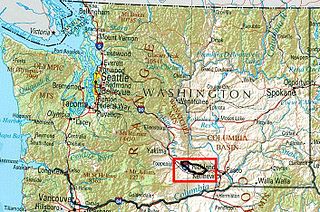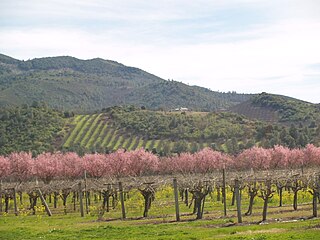Related Research Articles

The Willamette Valley AVA is an American Viticultural Area which lies in the Willamette Valley of Oregon. The AVA is the wine growing region which encompasses the drainage basin of the Willamette River. It stretches from the Columbia River in the north to just south of Eugene in the south, where the Willamette Valley ends; and from the Oregon Coast Range in the west to the Cascade Mountains in the east. At 5,360 square miles (13,900 km2), it is the largest AVA in the state, and contains most of the state's wineries; approximately 908 as of 2021.

The Southern Oregon AVA is an American Viticultural Area which lies in Southern Oregon, United States. The Southern Oregon AVA was established in 2005 and was created to include the land of two smaller AVAs: the Rogue Valley AVA and the Umpqua Valley AVA. Southern Oregon AVA was established to allow the two principal winegrowing regions in the southern part of the state to market themselves jointly. This creation of a "super-AVA" is a departure from the trend in the Willamette Valley AVA or northern Oregon of establishing smaller AVAs specific to a particular locale's climate or soil conditions.

The Applegate Valley AVA is an American Viticultural Area located in southern Oregon. It is entirely contained within the Rogue Valley AVA, which is itself included within the larger Southern Oregon AVA. The region is named for the Applegate River, which flows through the town of Applegate and near the city of Jacksonville. The Applegate Valley has been a grape-growing region since 1870 when A. H. Carson began planting 30 acres of grapes along North Applegate Road. One of Oregon's first wineries was established in the Applegate Valley. This region contains vineyards at altitudes ranging from 1,000 feet (300 m) to 1,500 feet (500 m) above sea level, and is warmer and drier than the Illinois Valley to the west, but less so than the Bear Creek Valley to the east. Grapes that thrive here include Tempranillo, Merlot, Cabernet Franc, Cabernet Sauvignon, Syrah, Tannat, Vermentino, Chardonnay, and Zinfandel.

The Yamhill-Carlton AVA is an American Viticultural Area located in both Washington County and Yamhill County, Oregon. It is entirely contained within the Willamette Valley AVA, and surrounds the towns of Carlton and Yamhill. The mountain ridges surrounding the AVA form a horseshoe shape, and most of the vineyards are located on south-facing slopes. The AVA includes only land between 200 feet (61 m) and 1,000 feet (305 m) above sea level where marine sediments are some of the oldest soils in the Willamette Valley and create unique conditions for viticulture. The region is in the rain shadow of the 3,500 feet (1,100 m) Oregon Coast Range, a short distance to the west.

The Rattlesnake Hills AVA is an American Viticultural Area located in Yakima County, Washington. United States Alcohol and Tobacco Tax and Trade Bureau (TTB) awarded Rattlesnake Hills its appellation status on March 20, 2006, making Rattlesnake Hills Washington's ninth federally recognized American Viticultural Area. The Rattlesnake Hills AVA is entirely contained within the Yakima Valley AVA, which is in turn is entirely contained within the larger Columbia Valley AVA. The hills form the northern boundary of Yakima Valley, and the AVA includes land between the north bank of the Sunnyside Canal and the entirety of the southern slopes of the Rattlesnake Hills between Outlook and the Wapato Dam. The AVA is centered on the city of Zillah. With elevations ranging from 850 feet (259 m) to 3,085 feet (940 m), this AVA contains the highest point in the Yakima Valley AVA.

Established in 2006 The Wahluke Slope AVA Wahluke, was named after a Native American word for "watering place," is an American Viticultural area located within Grant County, Washington and is home to more than 20 vineyards and at least three wine production facilities. It is part of the larger Columbia Valley AVA. The 80,490 acre region features approximately 8,931 acres of vineyards: nearly 15 percent of the total wine grape acreage in the state. Top grape varieties: Merlot, Syrah, Cabernet Sauvignon, Riesling, Chardonnay, and Chenin Blanc, but this area is primarily known for Merlot and Cabernet Sauvignon.

The Snake River Valley AVA is an American Viticultural Area that encompasses an area in Southwestern Idaho and two counties in eastern Oregon. The Idaho Grape Growers and Wine Producers Commission and the Idaho Department of Commerce and Labor filed the petition to recognize the AVA, and it was granted in 2007.
The Rocky Knob AVA is an American Viticultural Area in a mountainous area east of the Blue Ridge Parkway in southwest Virginia. The AVA includes portions of Floyd and Patrick counties. The area is located on the eastern slopes of the Blue Ridge Mountains near the towns of Woolwine and Meadows of Dan and astride the Blue Ridge Parkway. It was established in 1983 and encompasses 9,000 acres (36 km2). The soil is primarily loam and gravel and is well-drained. Rocky Knob AVA was named for the eponymously named mountainous recreational area located within the AVA.

The Howell Mountain AVA is an American Viticultural Area located within Napa Valley AVA of California.

The Texas Hill Country AVA is an American Viticultural Area located in the Texas Hill Country north of San Antonio and west of Austin, Texas. The appellation is the third largest American Viticultural Area in geographic area behind the Upper Mississippi River Valley AVA and Ohio River Valley AVA, covering an area of over 9,000,000 acres (14,062 sq mi). Established in 1991, it is the southernmost AVA. Today, there are around 80 wineries/vineyards. Despite the cultural influence of the local Texas German population, most of the grape varietals grown in the Texas Hill Country originate from France, Italy, or Spain rather than the cooler climate of Germany.

The Texas High Plains AVA is an American Viticultural Area located on the Llano Estacado region of Texas. The appellation is the second largest American Viticultural Area in Texas, and covers an area of over 270,000 acres (422 sq mi). Most of the vineyards are on flat terrain at elevations between 3,000 feet (914 m) and 4,000 feet (1,219 m) above sea level. The Texas plains can be extremely dry, so most vineyards are irrigated with water from the Ogallala Aquifer. The hardiness zones are 7a and 7b.
The Bell Mountain AVA is an American Viticultural Area located in Gillespie County, Texas. It was the first designated wine area located entirely in the state of Texas, and covers an area of over 3,200 acres (5 sq mi). The appellation is entirely contained within the Texas Hill Country AVA, which was established nine years after Bell Mountain AVA. As of 2006, there were nine wineries in the appellation.
The Escondido Valley AVA is an American Viticultural Area located in Pecos County, Texas. It was the fifth designated wine area in the state of Texas, and covers an area of over 32,000 acres (129 km2). There are no wineries located in the Escondido Valley AVA. The largest winery making Escondido Valley AVA designated wines was Ste. Genevieve Wines, whose winery facilities were located near Fort Stockton. Mesa Vineyards, owners of the Ste. Genevieve Winery, filed for bankruptcy in January 2022.
The Texoma AVA is an American Viticultural Area located in north central Texas, on the south side of Lake Texoma and the Red River that forms the border with the state of Oklahoma. The Texoma region is where 19th century viticulturist Thomas Volney Munson discovered that grafting Vitis vinifera grapevines onto native American varieties of vine rootstock resulted in vines that were resistant to phylloxera. The technique saved the European wine industry when it was brought to France, which was suffering its first phylloxera epidemic. The region was not designated an American Viticultural Area until 2005.

Lake County wine is an appellation that designates wine made from grapes grown mostly in Lake County, California and located north of Napa County. Although each region within Lake County has unique viticultural attributes, all are influenced by Clear Lake, the largest inland body of water in California. Lake County enjoys a reputation for bright, concentrated red wines made from Cabernet Sauvignon, Syrah and Zinfandel, and fresh, aromatic whites made from Sauvignon Blanc. Cabernet Sauvignon has the most acreage, with Merlot a distant second.
The Sonoita AVA is an American Viticultural Area located in southeast Arizona, south of the city of Tucson. The Sonoita area is a basin surrounded by three mountain ranges, the Huachuca Mountains, the Santa Rita Mountains, and the Whetstone Mountains. The vineyard plantings are 4,500 to 5,000 feet above sea level, some of the highest in North America. The soil is alluvial fans of gravelly loam that retains scarce water well.
The West Elks AVA is an American Viticultural Area located in Delta County, Colorado in and around the towns of Cedaredge, Hotchkiss and Paonia. It is one of two AVA's in the state. Some of the highest altitude vineyards in the northern hemisphere are planted within the AVA. Located within the North Fork Valley of the Rocky Mountains in west central Colorado, vineyards in the AVA range from 5,400 to 6,400 feet (1,646–1,951 m) above sea level. The surrounding mountains limit access to the area, resulting in a far more secluded wine industry when compared to its nearby neighbor to the northwest, the Grand Valley AVA.
The Ozark Highlands AVA is an American Viticultural Area located in southern Missouri in the Ozark Mountains. The appellation includes land from just east of Jefferson City in the north to the Eleven Point River in the south, including parts of Phelps, Maries, Osage, Gasconade, Franklin, Crawford, Shannon, Dent, Texas, Reynolds, and Pulaski counties. The AVA was established in 1987. Contained entirely within the larger Ozark Mountain AVA, the area is drier than other parts of the state, but the soil of sandy loam and clay retains moisture well. The first grapevines in the Ozark Highlands were planted by Italian immigrants. All variety of grapes are grown in the area, including Vitis vinifera, Vitis labrusca, and French hybrids.
References
- ↑ "§ 9.155 Texas Davis Mountains" (Title 27: Alcohol, Tobacco and Firearms; Part 9 — American Viticultural Areas; Subpart C — Approved American Viticultural Areas). Code of Federal Regulations. July 10, 2008. Retrieved November 27, 2007.
- 1 2 3 4 "Texas Davis Mountains (AVA): Appellation Profile". Appellation America. 2007. Archived from the original on April 4, 2016. Retrieved November 15, 2007.
- ↑ "The Wine Growing Regions of Texas". Go Texas Wine. Texas Department of Agriculture. 2006. Archived from the original on July 26, 2011. Retrieved December 16, 2007.